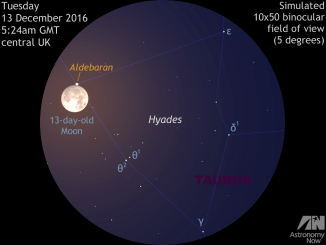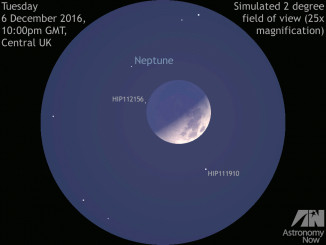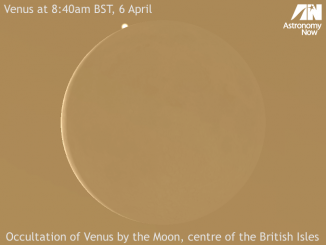
occultation


See the Moon hide Aldebaran in Taurus on 12-13 December
On the night of 12-13 December, the waxing gibbous Moon glides in front of the loose open star cluster known as the Hyades in the constellation of Taurus, culminating in the occultation of bright star Aldebaran around 5:24am GMT for observers in the British Isles. In North America, the event occurs at a more sociable hour late into the evening of 12 December.


Let the Moon be your guide to locating planet Neptune on 9 November
The penultimate 2016 occultation of Neptune by the Moon occurs on 9 November for observers in Western Asia, Eastern Europe and northernmost Africa. In Western Europe, the nine-day-old waxing gibbous Moon merely brushes by the outermost planet, but the pair will be close enough to be seen within the same field of view of a typical binocular from the UK.

See the Moon hide planet Neptune on 15 September
Observers up for an extreme observing challenge may care to make an attempt at viewing the almost full Moon pass in front of planet Neptune soon after 8pm BST on Thursday, 15 September. The planet’s disappearance occurs at a low altitude in twilight for the British Isles, but can also be seen from a large swathe of Europe and western Russia.

See the crescent Moon get close to Jupiter on Saturday, 9 July
If the excitement of the Juno spacecraft’s arrival at Jupiter has prompted you to seek out the solar system’s largest planet, then the 5-day-old cresent Moon acts as a convenient celestial guide during the evening of Saturday, 9 July when it makes a close pass of the gas giant. Here’s our guide to where and when to see this beautiful celestial pairing.


See the Moon invade the Hyades star cluster on 10 April
If you have a clear western horizon from shortly before 9pm BST until midnight on Sunday, 10 April, don’t miss an opportunity to see a young crescent Moon glide slowly through the southern edge of the Hyades star cluster in Taurus, covering (or occulting) stars as it goes. All you need is a typical binocular or a small telescope to enjoy the show!

The Moon hides Venus in the morning sky
On the morning of Wednesday, 6 April experienced observers in the British Isles with a clear sky living south of a line drawn between Galway in Ireland, Dumfries in Scotland and Berwick-upon-Tweed in Northumberland can potentially observe planet Venus slip behind the northern polar regions of the 28-day-old waning crescent Moon. But beware: the Sun lies just 16 degrees away.

Jupiter continues to delight and amaze observers during April
The impact of a small comet or asteroid on Jupiter observed by European amateur astronomers on 17 March has heightened interest in the solar system’s largest planet. While such an event is uncommon, Jupiter and its family of four bright Galilean moons provide a wealth of other interesting phenomena to view with small telescopes during April.
